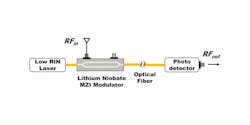The military/defense industry continues to encourage the advancement of multifunctional receivers. Yet the demands for higher-frequency operation, increased bandwidth, increased dynamic range, and enhanced sensitivity create unique design challenges for present technology. Size, weight, power, and cost (SWAP-C) dynamics heavily influence the military/defense industry’s value for a particular technology. As a potential technological leap forward, DARPA has been investigating the development of microwave photonic technology. Researchers from DARPA, Richard W. Ridgway and Joshua A. Conway—together with Carl L. Dohram, a researcher from Booz Allen Hamilton—have reviewed DARPA’s progress toward advancing microwave photonics in the last 10 years.
Microwave photonic technology has the potential to dramatically reduce all of the SWAP-C parameters of a traditional RF telecommunications link. Thus, significant effort has been invested in replacing a link’s RF components with photonic ones. DARPA has identified three dominant components that could enable a photonic link: low-noise/high-power laser diodes, low-loss/low-drive-voltage electro-optic modulators, and high-power/highly linear photodiodes.
For laser diodes, high output power and low relative intensity noise (RIN) are essential for maintaining a low noise figure and significant dynamic range. DARPA research groups have demonstrated several of these technologies, including the following: a tunable, sampled-grating distributed Bragg grating laser, indium phosphide (InP) slab-coupled optical-waveguide external cavity lasers, and InP distributed feedback lasers.
For electro-optical modulators, the Mach-Zehnder modulator (MZM) has become the dominant technology for high-performance applications. Lithium-niobate modulators have been used for some time for MZM devices. Recently, however, gallium-arsenide (GaAs) and aluminum-gallium-arsenide (AlGaAs) MZM systems have been developed. In terms of photodiode technology, the uni-traveling-carrier (UTC) photodiode has become a favored architecture for high-performance receivers. A significant achievement of this technology was achieving an RF output power of 750 mW at 15 GHz with a third-order intercept point of less than +55 dBm. See “Microwave Photonics Programs at DARPA,” Journal Of Lightwave Technology, Oct. 2014, p. 3428-3439.
About the Author
Jean-Jacques DeLisle
Jean-Jacques graduated from the Rochester Institute of Technology, where he completed his Master of Science in Electrical Engineering. In his studies, Jean-Jacques focused on Control Systems Design, Mixed-Signal IC Design, and RF Design. His research focus was in smart-sensor platform design for RF connector applications for the telecommunications industry. During his research, Jean-Jacques developed a passion for the field of RF/microwaves and expanded his knowledge by doing R&D for the telecommunications industry.

